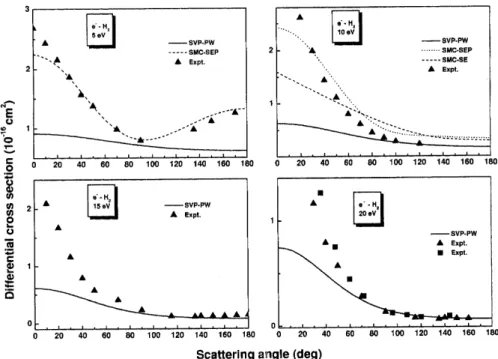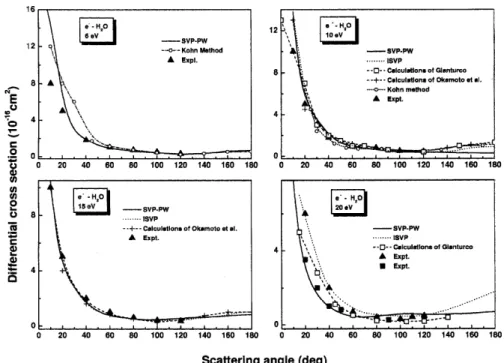Studies of Eletron-Moleule Collisions Using the
Shwinger Variational Priniple with Plane
Waves as a Trial Basis Set
Jorge L. S. Lino
N uleode PesquisasemMatematiae
MatematiaApliada,Universidade BrazCubas,
Campus I,0877-380MogidasCruzes,S~aoPaulo,Brazil
Maro A. P. Lima
InstitutodeFsia,Uniamp,
13083-970Campinas,S~aoPaulo,Brazil
Reeived10February,2000
Wereportelastidierentialrosssetions(DCS)forthesatteringofeletronbyH2,CH4,C2H4,
SiH4, and H2O in the 5 to 20 eV energy range. These ross setions were obtained using the
Shwinger variational priniple. Inourproeduresthesattering wave funtionisexpanded as a
ombinationofplanewaves. Inthepresentimplementationtheexhangepotentialandpolarization
eets arenotonsideredandall resultsareobtainedat thestatilevelofapproximation. Forall
moleules, exeptH2,ouralulated DCSagree reasonably wellwithavaliable experimentaldata
and with othertheoretial results (obtainedat the stati-exhangelevel of approximation). Our
studysuggeststhattheShwingervariationalpriniplewithplanewaveexpansionmaybeomean
eÆientmethodforstudyingeletron-moleulesattering.
Among the rst-priniple methods, the Shwinger
variationalpriniple(SVP) [1℄ hasreeivedspeial
at-tention in the last ouple of deades. The rst
al-ulations using theSVP foreletron-moleule
satter-ing were presented by MKoyand o-workersusing a
separable form for the Green's funtion [2℄. To
a-ountforpolarizationeetsandmultihanneloupling
(duetoinelasti proessesinvolvingenergetiallyopen
eletroniexitedstates),TakatsukaandMKoy
intro-dued modiations into the SVP and reated the so
alledShwingerMultihannelMethod(SMC)[3℄.
Sev-eralappliationsofthismethodarereportedinthe
lit-erature [4℄. Later on, studies using the SMC method
withnormonservingpseudopotentials[5℄wereshown
tobeveryusefulformoleulesontainingheavyatoms
[6℄. InadditiontoappliationsofShwingerVariational
type of methods, several other studies using iterative
proedures (ISVP) to solve the Lippmann-Shwinger
equation have also been applied to eletron-moleule
sattering alulations [7-11℄. The main limitation of
themethod(SVP orSMC)residesonwhat makesita
generalmethod: theexpansionof the sattering
fun-tion is done in a L 2
basis (Cartesian Gaussian
fun-tions) and this is very eetive only for short-range
potentials. An importantdevelopment of the method
would be to allow inlusion of plane waves (PW) in
the sattering basis and this is the motivation of the
presentpaper. Inorder to dothis, wehavedeveloped
omputerodesinvolvingmatrix elementsof the type
< ~
k
f jVG
(+)
0 V j
~
k
i
>(seond-Borntypeofterms)with
norestritionsonmoleulargeometries[12,13℄. Inthis
paperwepresentresultsfore -H
2 ,CH
4 ,C
2 H
4 ,SiH
4 ,
and H
2
Osattering in thestatiapproximationin the
(5-20)-eV energy range. Although the orret
treat-mentofexhangeandofpolarizationeetsisknownto
beimportantforlow-energysattering,wesurprisingly
found that the present statiresults are in very good
agreementwithexperimental data for allmoleules of
theabovelist,exeptforH
2
at5and10eV,andforCH
4
at5eV.Ourresultsarealsousefultoestablish
benh-markalulationsat thestatilevelofapproximation,
indispensable in the development of a more omplete
formalisminludingexhange and polarization eets.
Other partiular interest is to hek if theSVP using
planewavesis apable,for instane, ofdesribing
refertheSVPusingplanewavesasSVP-PW.
IntheSVPforeletron-moleuleelastisattering,
thebilinearvariationalformofthesatteringis
f( ~ k f ; ~ k i )℄= 1 2 f<S ~ kf jV j
(+)
~
ki
>+< ( )
~
k
f
jV jS
~ ki > < ( ) ~ k f
jV VG (+) 0 V j (+) ~ ki >g (1) d
Here jS
~
ki
>is theinputhannel staterepresentedby
theprodutofaplanewave ~
k
i
timesj
0
>,theinitial
(ground)targetstate. jS
~
k
f
>hasanalogousdenition,
exept that the plane wave points to ~
k
f
, V is the
in-terationbetweentheinidenteletronandthetarget,
G (+)
0
is the projeted Green's funtion, written as in
theSMCmethod[14℄:
G (+) 0 = Z d 3 k j 0 ~ k>< ~ k 0 j (E H 0 +i) (2) H 0
istheHamiltonianfortheNeletronsofthetarget
plusthekinetienergyoftheinidenteletronandE
is totalenergyof thesystem(target +eletron). The
satteringstatesj (+)
~
ki
>and< ( )
~
k
f
jareprodutsof
the targetwavefuntion j
o
> andone-partile
sat-teringwavefuntion. Theinitial stepin ourSVP
al-ulationsisto expandtheone-partilesatteringwave
funtions asaombination of planewaves. So, in the
statiapproximation,forelastisattering,the
expan-sionofthesatteringwavefuntionisdoneinadisrete
formas j (+) ~ ki >= X m a m ( ~ k m )j 0 ~ k m > (3) j ( ) ~ kf >= X n b n ( ~ k n )j 0 ~ k n > (4)
TheinlusionofthesedenitionsinEq.(1)andthe
appliation of astationarity ondition[1, 13℄ with
re-spet totheoeÆients,givestheworkingform ofthe
satteringamplitude: [f( ~ k f ; ~ k i )℄= 1 2 ( X mn <S ~ k f jV j
0 ~ k m >)(d 1 ) mn < ~ k n 0 jV jS
~ ki >) (5) where d mn =< 0 ~ k m
jV VG (+) 0 V j 0 ~ k n > (6) d
We haveimplemented a set of omputational
pro-grams to evaluateallmatrixelementsof Eq.(5). The
Green'sfuntiongiveninEq.(2)anditsassoiated
dis-ontinuitieshavebeenexaminedandtreatedin a
simi-larwayasinthesubtrationmethod [15,14, 13℄. Our
disrete representationofthesattering wavefuntion
(given by Eqs. (3) and (4)) is made only in two
di-mensionalspae(spherialoordinates,usingGaussian
quadratures for and and the on-shell k value for
the radial oordinate). To illustrate, we present
re-sults of appliations of the present method for elasti
sattering of eletrons by H
2 , CH 4 , C 2 H 4 , SiH 4 and H 2
O,forseveralimpatenergies(from5to20eV).For
resent the ground state of the targets with the same
CartesianGaussianbasisset expansionthathavebeen
used in previous alulations with the SMC method
(Ref.[16℄forH
2
,Ref.[17℄forCH
4
,Ref.[18℄forC
2 H
4 ,
Ref.[19℄forSiH
4
, andRef.[20℄forH
2 O).
Fig. 1 shows our DCS for H
2
along with seleted
experimentaldata([21,22℄). Asnoted,at5eVthe
ab-seneofexhangeandpolarizationontributionsauses
anoverallunderestimationof thealulatedross
se-tion. Above 10eV, the SVP-PW generallyagree well
with the experimental data, exept at near forward
Figure1. ElastiDCSfore -H2 satteringat5,10, 15and20eV.PresentresultsSVP-PW:solidline;experimentaldata
ofRefs.[21 ,22 ℄: fulltrianguleandsquaresymbols,respetively.
Figure2. ElastiDCSfore -CH4satteringat5,10,15and20eV.PresentresultsSVP-PW:solidline;experimentaldata
ofRef.[23 ℄: fulltriangule;resultsoftheSMCmethodusingstati-exahangeapproximationofRef.[24 ℄: dashedline;results
oftheISVPinstati-exhange-plus-polarizationapproximation ofRef.[25 ℄: dottedline.
Fig. 2 shows our DCS for CH
4
with
experimen-tal data of Tanakaet al. [23℄. Theoretial ross
se-tions using stati-exhange (SE) approximation with
theShwinger MultihannelMethod [24℄ anditerative
son. Again, the dierenesat 5eV are expeted, due
to thefatthat wearenegletingexhangeand
polar-ization eets. Above 5 eV, however,the omparison
Figure 3. ElastiDCSfor e -C2H4 sattering at5,8,15.5 and30eV. Present results SVP-PW:solidline; experimental
dataofRef.[26 ℄: full triangule; resultsoftheISVPusingstati-exhange-plus-polarization ofRef.[27 ℄: dottedline;results
ofSMCmethodusingstati-exhangeofRef.[18 ℄: dashedline.
Fig. 3showsourDCSforC
2 H
4
alongwith
experi-mentaldata([26℄)andtheoretialresultsobtainedwith
the Shwinger Multihannel Method [18℄ and iterative
Shwinger Method [27℄, both at the stati-exhange
plus polarization (SEP) level of approximation. As
noted, for all energies, our DCS are reasonably lose
totheexperimentalandtheoretialresults.
Figure4. ElastiDCSfore -SiH4 satteringat5,10,15and20eV.PresentresultsSVP-PW:solidline;experimentaldata
Fig. 4 shows DCS for SiH
4
. Again, for all
en-ergies, our results using the SVP-PW at the stati
level of approximation are very lose to experimental
results [29℄ and to theoretial results obtained at the
stati-exhange level of approximation with the SMC
method[19℄.
Figure5. ElastiDCSfor e -H2Osatteringat 6,10, 15, and20eV. Present resultsSVP-PW:solidline; experimental
data of Ref. [34 , 35 ℄: full triangule and full square symbols, respetively; results of the ISVP using stati-exhange of
Ref. [30 ℄: dottedline; alulations ofOkamotoetal. usingstati-exhange-polarization[31℄: plus-dashedline; alulations
ofGianturo [32 ℄: dashedlinewithopensquare.
Finally, Fig. 5 shows DCS for H
2
O. Theoretial
studies[30-33℄are alsoinludedfor omparison
when-ever available. As expeted for H
2
O, due to the
per-manent dipole moment, our ross setions show very
strongforward-peaking. Agreementbetweenour
alu-lated rosssetionsand available experimental datais
generallygood. Ourresultsalso agree quitewellwith
other theoretial studies over the angular and energy
regionsoveredhere.
Insummary, although exhange potential and
po-larizationeets arenottakeninto aountinour
al-ulations, our results are, in general, in good
agree-mentwithexperimentalandothertheoretialmethods
forelastieletronsatteringofH
2 , CH
4 , C
2 H
4 , SiH
4 ,
and H
2
O over the range of aproximately 5 to 20 eV.
Inthefuture,weplantoextendthepresentmethodto
investigatethe thelower-energysatteringrange from
0to5eV.Thiswillbedonebyimplementingtheplane
wave expansion in the SMC method, where exhange
and polarization eets anbe treatedin an ab-initio
form.
The researh of J.L.S.L. is supported by the
Funda~ao de Amparo a Pesquisa do Estado de
S~ao Paulo (Fapesp) and Nuleo de Pesquisas em
pemap), Brazil. M.A.P.L aknowledge support from
Brazilian agengy Conselho Naional de
Desenvolvi-mentoCientioeTenologio(CNPq). These
alula-tionsweremadeatCentroNaionaldeProessamento
deAltoDesempenho(CENAPAD-Nordeste) and
ITA-CTA. The authors also anowledge Dr. L. M.
Bres-ansinforinsightfuldisussions.
Referenes
[1℄ J.Shwinger,Phys.Rev.72,1763(1947);B.A.
Lipp-mannandJ.Shwinger,Phys.Rev.79,469(1950).
[2℄ T.N.Resigno,C.W.MCurdy,andV.MKoy,Chem.
Phys.Lett.27,401(1974);T.N.Resigno,C.W.
M-Curdy,andV.MKoy,Phys.Rev.A10,2240(1974).
[3℄ K.Takatsuka,V.MKoy,Phys.Rev.A24,2473(1981);
K.Takatsuka,and V.MKoy,Phys.Rev.A 30,1734
(1984).
[4℄ See,forexample,C.WinsteadandV.MKoy,Advanes
inChemialPhysis,Vol.XCVI,EditedbyI.Prigogine
andStuartA.Rie,1996andreferenestherein.
[5℄ M. H.F.Bettega, L.G.Ferreira,and M.A.P.Lima,
Phys.Rev.A47,1111 (1993).
M. H.F.Bettega, L. G.Ferreira,and M.A. P.Lima,
Phys.Rev.A59, 879(1999);M.T.doN.Varella,M.
H. F.Bettega, A. J.R.daSilva,and M. A.P.Lima,
J.Chem.Phys.110,2452 (1999);M.T.doN.Varella,
L.G.Ferreira,andM.A.P.Lima,J.Phys.B32,2031
(1999).
[7℄ R. R. Luhese and V. MKoy, J. Phys.B 12, L421
(1979); R. R. Luhese, G. Raseev, and V. MKoy,
Phys.Rev.A25,2572(1982); R.R.LuheseandV.
MKoy,Phys.Rev.A25,1963 (1982).
[8℄ L. M. Tao, L. M. Bresansin, M. A. P. Lima, L. E.
Mahado,andE.P.Leal,J.Phys.B23,4331(1990).
[9℄ S.K.Adhikari,Chem.Phys.Letters,258,596(1996);
S.K.AdhikariandK.L.Kowalski,Dynamialollision
theory anditsappliation(AademiPress,NewYork,
1991)andreferenestherein.
[10℄ J. Horaek and T. Sasakawa, Phys. Rev.A 30, 2274
(1984).
[11℄ M.-T. Lee, I. Iga, M. M. Fujimoto, and O. Lara, J.
Phys.B28,L299(1995).
[12℄ D. K.Watson andV.MKoy,Phys.Rev.A 20,1474
(1979);A.W.FlietandV.MKoy,Phys.Rev.A21,
1863 (1980).
[13℄ J. L. S. Lino, Ph. D. Thesis (1995), Instituto
Te-nologiodeAeronautia,CentroTenioAeroespaial,
S~aoJosedosCampos,S~aoPaulo,Brazil.
[14℄ M. A. P.Lima, L. M. Bresansin, A. J. R. Silva, C.
WinsteadandV.MKoy,Phys.Rev.A41,327(1990).
[15℄ S. K. Adhikari and L. Tomio, Phys. Rev. C 37, 41
(1988).
[16℄ M. A. P. Lima,T.L. Gibson, V. MKoy, and W.M.
Huo,Phys.Rev.A38,4527(1988).
[17℄ C.Winstead,Q.Sun,V.MKoy,J.L.S.Lino,andM.
A.P.Lima,J.Chem.Phys.98,2132(1993).
[18℄ C. Winstead, P. G. Hipes, M. A. P. Lima, and V.
MKoy,J.Chem.Phys.94,5455(1991).
[19℄ C. Winstead and V. MKoy, Phys. Rev.A 42, 5357
(1990).
[20℄ L. M. Bresansin, M. A. P. Lima,L. E. Mahado, L.
M.Tao,Braz.J.Phys.22,221(1992).
[21℄ S.K.Srivastava,A.ChutjianandS.Tajmar,J.Chem.
Phys.63,2659(1975).
[22℄ T.W.Shynand W.E.Sharp,Phys.Rev.A24,1734
(1974).
[23℄ H. Tanaka,T. Okada, L. Boesten, T. Susuki,T.
Ya-mamoto,andM.Kubo,J.Phys.B15,3305 (1982).
[24℄ M. A. P. Lima, T. L. Gibson, W. M. Huo, and V.
MKoy,Phys.Rev.A32,2696(1985).
[25℄ L.E.Mahado,M.T.LeeandL.M.Bresansin,Braz.
J.Phys.28,111(1998).
[26℄ B.MapstoneandW.Newell,J.Phys.B25,491(1986).
[27℄ L.M.Bresansin,L.E.MahadoandM.T.Lee,Phys.
Rev.A57,3504(1998).
[28℄ T.N. Resigno and B.H. Lengseld, Z. Phys.D24,
117(1992).
[29℄ J.Perrin,J.P.M.Shmitt,G.deRosny,B.Drevillon,
J.Hu,andA.Lloret,Chem.Phys.73,383(1982).
[30℄ L.E.Mahado,L.M.Tao,L.M.Bresansin,M.A.P.
LimaandV.MKoy,J.Phys.B28,467(1995).
[31℄ Y.Okamoto, K.OndaandY.Itikawa,J.Phys.B26,
745(1993).
[32℄ F.A.Gianturo,J.Phys.B24,3837(1991).
[33℄ A. Jain and D. G. Thompson, J. Phys. B 16, 3077
(1987).
[34℄ W.M.JohstoneandW.R.Newell,J.Phys.B24,3633
(1991).
[35℄ A.Danjo and H. Nishimura,J. Phys.So.Japan 54,


